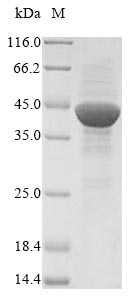The gene coding for the Pig ANPEP protein (616-963aa) is introduced into a plasmid vector, creating recombinant plasmid that is subsequently transformed into e.coli cells. e.coli cells capable of surviving in the presence of a specific antibiotic are selected and then cultured under conditions favorable for the expression of the gene of interest. A N-terminal 10xHis tag and C-terminal Myc tag is attached to the protein. Post-expression, the recombinant Pig ANPEP protein is isolated and purified from the cell lysate using affinity purification. Denaturing SDS-PAGE is applied to resolve the resulting recombinant Pig ANPEP protein, revealing a purity exceeding 85%.






